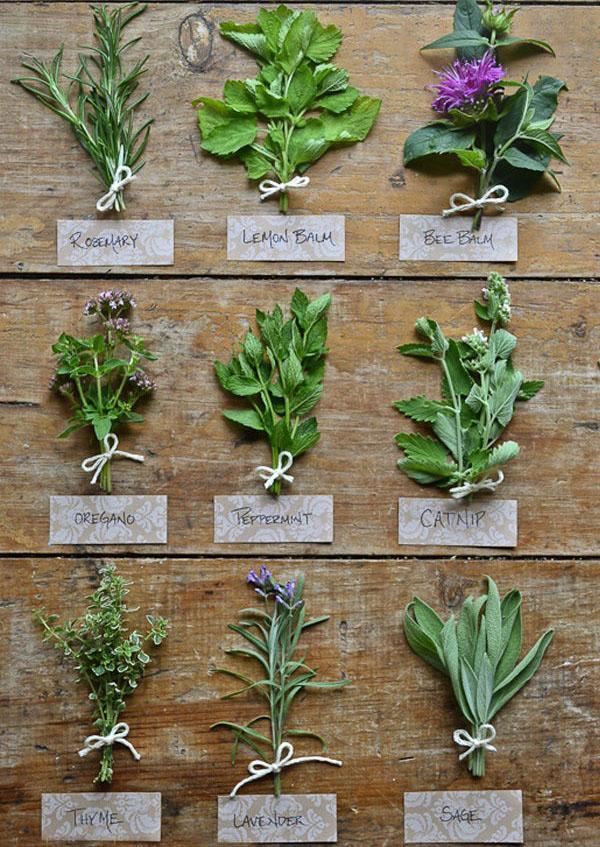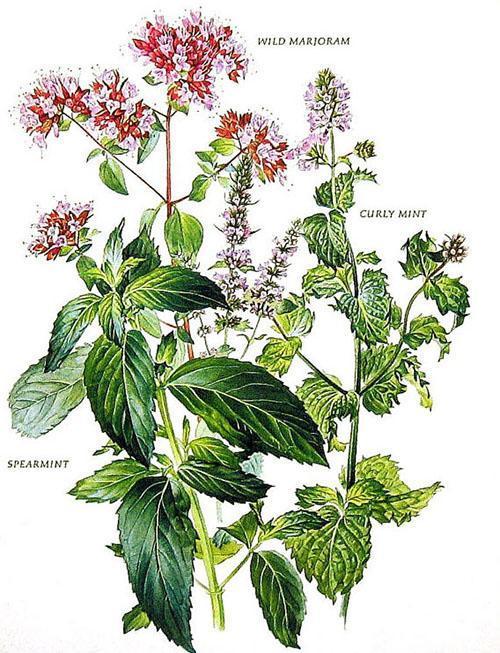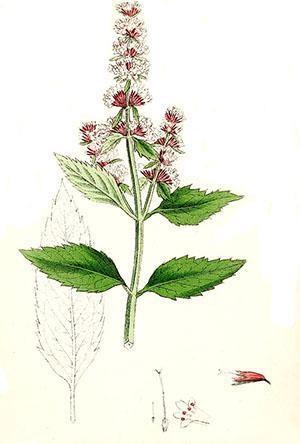The healing properties of different types of mint
 Due to its bright refreshing aroma, mint has long become a leader among spicy herbs. The leaves, stems and flowers of the plant are used by culinary specialists and perfumers; on the basis of plant raw materials, a variety of medicines and traditional medicine are made. But when pouring mint tea, treating yourself to fragrant gingerbread or using toothpaste with a characteristic cooling taste, only a few think about what kind of raw mint was used. Indeed, under the short name “mint"There can be dozens of related plants that have similar traits and properties inherent in only one variety.
Due to its bright refreshing aroma, mint has long become a leader among spicy herbs. The leaves, stems and flowers of the plant are used by culinary specialists and perfumers; on the basis of plant raw materials, a variety of medicines and traditional medicine are made. But when pouring mint tea, treating yourself to fragrant gingerbread or using toothpaste with a characteristic cooling taste, only a few think about what kind of raw mint was used. Indeed, under the short name “mint"There can be dozens of related plants that have similar traits and properties inherent in only one variety.

Today, about two dozen species of mint have been cultivated and grown in garden beds in gardens and as indoor plants. Moreover, on different continents, people find and give preference to their favorite varieties.
There is, for example, English, Australian and even Japanese mint, which is not found anywhere in the world, except on several islands in the Land of the Rising Sun. In Russia, the most popular species are those that grow here both natively and brought from Europe, for example, the most common mint is peppermint. What is the effect on the body of a particular type of mint?
Peppermint: beneficial properties and contraindications
 It is extremely difficult to meet wild peppermint, because this plant is a hybrid of European varieties obtained several centuries ago, noticed and spread first in Western Europe, and then throughout the world. Today, peppermint plantations intended for food, perfumery, and pharmaceutical industries exist in four dozen countries. Why the plant became so famous, and from what it helps peppermint?
It is extremely difficult to meet wild peppermint, because this plant is a hybrid of European varieties obtained several centuries ago, noticed and spread first in Western Europe, and then throughout the world. Today, peppermint plantations intended for food, perfumery, and pharmaceutical industries exist in four dozen countries. Why the plant became so famous, and from what it helps peppermint?
The aroma of peppermint is due to the high concentration of essential oil in the greenery, the main component of which is menthol with a cooling and even scalding taste and aroma. Therefore, the plant is sometimes called menthol mint, and the beneficial properties and contraindications related to it, for the most part, extend to closely related species. In addition to the menthol-rich essential oil, peppermint greens contain tannins and vitamins, natural bitterness and minerals, a lot of organic acids, esters and phytoncides.
The secret of the plant's popularity lies in the composition of its leaves, stems and flowers used to obtain medicines, decoctions, tinctures and fragrances.
It is these substances that act on the body, and mint is recognized as an effective herbal remedy for combating pathogenic flora on the mucous membranes of the intestines and oral cavity, in the nasopharynx and on the skin. Herbal raw materials are used in eliminating digestive problems, treating the liver and gall bladder, nervous and respiratory systems. Peppermint-based preparations can relieve headaches and toothaches, and have been tested for the treatment of migraines, heart and vascular diseases.
Mint tea is an established sedative and is also a good help in treating colds and inflammations.
Many are interested in how mint affects blood pressure? Peppermint has the ability to lower blood pressure, promotes faster digestion of food and relieves pain.
These are the medicinal properties of peppermint, but are there any contraindications? Yes, such an active herbal remedy, especially preparations with a high content of peppermint essential oil, cannot be used by pregnant and lactating women, as well as children under three years old. The antihypertensive effect of peppermint can make people with low blood pressure feel unwell. And the calming effect sometimes affects the reaction speed of car drivers.
Lemon mint: useful properties and contraindications
 Lemon balm or lemon mint, as this plant is called for its amazing aroma, which has notes of citrus and menthol at the same time, can bring no less benefit to the body.
Lemon balm or lemon mint, as this plant is called for its amazing aroma, which has notes of citrus and menthol at the same time, can bring no less benefit to the body.
The beneficial properties of lemon mint and contraindications for this plant are due to the composition of the leaves, tops of stems and inflorescences used for food and for treatment. The plant, like peppermint, is rich in essential oils, but their composition is slightly different, which is reflected in the aroma of the herb and its qualities. Lemon balm herb also contains vitamins, among which the main place is occupied by ascorbic acid, there are tannins, tannins and mineral elements, saponins and flavonoids, natural bitterness and valuable organic acids in the leaves and stems of the plant.
What does lemon mint help to fight off, and how does it affect the human body? Like peppermint, lemon balm can effectively relieve pain and emotional stress, neutralize unreasonable anxieties and activate the brain. Herbal remedies based on lemon mint leaves have antipyretic, diaphoretic, diuretic and anti-inflammatory effects.
Melissa is beneficial for a number of gastrointestinal problems. Decoctions and infusions of this herb stimulate intestinal motility, making it clear of gases and toxins, effectively fight constipation, relieve spasms and improve appetite.
 Lemon mint acts on the body for heart and vascular diseases, reducing the risk of atherosclerosis and stroke. The strengthening effect of lemon balm is in demand by patients with anemia, neuralgia, the plant can help with migraine and spasmodic, for example, menstrual pain.
Lemon mint acts on the body for heart and vascular diseases, reducing the risk of atherosclerosis and stroke. The strengthening effect of lemon balm is in demand by patients with anemia, neuralgia, the plant can help with migraine and spasmodic, for example, menstrual pain.
Melissa is widely used in the treatment of fungal skin infections, eczema and youthful acne, as well as diseases associated with disorders of the immune system. Because lemon balm oil is an excellent natural antiseptic. Lemon mint-based products are used as lotions, lotions and compresses for gout, herpes, and oral diseases.
With a mass of useful properties similar to peppermint, contraindications for taking lemon balm are also close.
People with hypertension should not abuse fresh and dried herb, because, like mint, it affects blood pressure and lemon balm. Women in the first months of pregnancy and those who are prone to allergic reactions to the components of plant materials should also be careful about the properties of the plant.
Long-leaved mint: medicinal properties and contraindications
 Long-leaved mint, which has long been a wild plant, is now grown in gardens. This large herbaceous crop has a pleasant smell, close to other types of mint, and in Russia it is found both in the middle zone and in the West of Siberia. The basis of the existing contraindications and medicinal properties of long-leaved mint is the rich composition of essential oils found in its greenery. In addition to menthol, linalool and pulegon are present here, as well as carvacrol, which, according to recent studies, has shown pronounced antimicrobial properties.
Long-leaved mint, which has long been a wild plant, is now grown in gardens. This large herbaceous crop has a pleasant smell, close to other types of mint, and in Russia it is found both in the middle zone and in the West of Siberia. The basis of the existing contraindications and medicinal properties of long-leaved mint is the rich composition of essential oils found in its greenery. In addition to menthol, linalool and pulegon are present here, as well as carvacrol, which, according to recent studies, has shown pronounced antimicrobial properties.
Longleaf mint is considered to be the leader in its family for pain relieving and antiseptic properties.In this regard, mint acts on the body:
- with headaches, stomach pains, toothaches;
- with intolerable painful menstruation;
- with viral diseases and colds;
- with inflammatory processes in the oral cavity and nasopharynx.
Effect on the body of curly mint
 Unlike the previously described types of mint, the medicinal properties and contraindications of which depended on the presence of menthol in parts of the plants, curly mint has a different set of active ingredients in essential oil. It includes pulegon, cineole and carvone, linalool and limonene. It is for this essential oil that the plant is widely cultivated and used by pharmacists.
Unlike the previously described types of mint, the medicinal properties and contraindications of which depended on the presence of menthol in parts of the plants, curly mint has a different set of active ingredients in essential oil. It includes pulegon, cineole and carvone, linalool and limonene. It is for this essential oil that the plant is widely cultivated and used by pharmacists.
What does spearmint help from? At this time, the concentration of essential oils reaches a maximum, and the resulting raw materials can be used as an effective pain reliever and sedative.
The collection of leaves that do not have the smell of menthol, and the tops of the shoots are carried out shortly before and during flowering.
Useful properties of field mint
 Field mint is a well-known wild-growing species in Russia, the plants of which contain up to 2% of a bitter, pungent-smelling essential oil. The main component responsible for the beneficial properties of field mint is menthol. Other constituents, such as vitamins, organic acids, terpenes and tannins, play an important role.
Field mint is a well-known wild-growing species in Russia, the plants of which contain up to 2% of a bitter, pungent-smelling essential oil. The main component responsible for the beneficial properties of field mint is menthol. Other constituents, such as vitamins, organic acids, terpenes and tannins, play an important role.
The plant has medicinal properties and contraindications in common with different types of mint. But it is more often used externally and internally as an anti-inflammatory natural remedy that can calm and gently relieve pain.
Catnip: beneficial properties and uses
 Catnip or catnip smell is most reminiscent of lemon balm, since its essential oil does not contain such an aggressive component as menthol, but nepelactone is present, as well as other aromatic substances, which include geraniol, carvacrol and limonene. There are citral tannins and vitamins, phytoncides and terpenes in the composition of catnip greens. What is the effect on the body of catnip?
Catnip or catnip smell is most reminiscent of lemon balm, since its essential oil does not contain such an aggressive component as menthol, but nepelactone is present, as well as other aromatic substances, which include geraniol, carvacrol and limonene. There are citral tannins and vitamins, phytoncides and terpenes in the composition of catnip greens. What is the effect on the body of catnip?
Decoctions and fresh herbs stimulate digestion, effectively soothe and help fight the weakness that accompanies anemia. Do the medicinal properties and contraindications of different types of mint differ when compared with catnip? The main properties of plant raw materials, as well as possible risks, are common, however, catnip is also used as a natural antiparasitic agent, acting against intestinal parasites, ticks and garden pests.
Catnip is recommended by folk medicine as a means of stimulating appetite, helping to relieve coughing, tonic and pain relieving.
Useful properties of dog mint or ivy budra
 A herbaceous plant related to cultivated species of mint and widespread in the wild throughout the country, the attention of gardeners and truck farmers is undeservedly bypassed. What are the medicinal properties and contraindications of dog mint? The greens of unpretentious dog mint contain quite a lot of tannins and natural bitterness, carotene, essential oils, amino acids, saponins, as well as ascorbic, caffeic, tartaric and mustard acids.
A herbaceous plant related to cultivated species of mint and widespread in the wild throughout the country, the attention of gardeners and truck farmers is undeservedly bypassed. What are the medicinal properties and contraindications of dog mint? The greens of unpretentious dog mint contain quite a lot of tannins and natural bitterness, carotene, essential oils, amino acids, saponins, as well as ascorbic, caffeic, tartaric and mustard acids.
The herb will be useful for inflammatory and infectious diseases of the respiratory tract, liver and gallbladder. A decoction of budra will help relieve stomach and renal colic, restore appetite.
Externally, herbal raw materials and decoctions from it are used for abscesses, inflammatory processes on the skin, eczema and gout, edema. The herb has a wound healing, calming effect. But there are not only medicinal properties, but also contraindications, because, like different types of mint, budra is saturated with biologically active substances that require a careful approach.
The healing effect of mint on the body is versatile and very powerful.Despite its inconspicuousness, budra is an excellent and anti-inflammatory agent.
Useful properties of room mint or plectrantus
 Housewives love to grow a popular houseplant. which is a relative of cultivated mint species. This is confirmed by the pleasant pungent aroma of camphor and menthol emanating from the pounded greens of plectranthus growing in pots on the windowsills. This is how the essential oils that make up the aerial part of the plant make themselves felt. But what are the health benefits of roommint?
Housewives love to grow a popular houseplant. which is a relative of cultivated mint species. This is confirmed by the pleasant pungent aroma of camphor and menthol emanating from the pounded greens of plectranthus growing in pots on the windowsills. This is how the essential oils that make up the aerial part of the plant make themselves felt. But what are the health benefits of roommint?
The essential oils of this houseplant, like phytoncides, have a disinfecting effect, which positively affects the quality of the indoor atmosphere. In addition, the aroma of room mint is able to deodorize the air well, have a beneficial effect on the well-being of people nearby, improve efficiency and tone up.
The negative influence of plectrantus is felt by insects annoying the inhabitants of the house: mosquitoes, flies and moths.
Contraindications to the use of mint
 With the pronounced medicinal properties of various types of mint, contraindications to taking herbal preparations are quite extensive and serious. Since mint affects blood pressure, lowering it, you should not abuse herbal remedies for people with hypotension. Similarly, the calming effect of the plant is accompanied by a decrease in the number of heart contractions, which means that patients with heart ailments should carefully use drugs with menthol and mint herb.
With the pronounced medicinal properties of various types of mint, contraindications to taking herbal preparations are quite extensive and serious. Since mint affects blood pressure, lowering it, you should not abuse herbal remedies for people with hypotension. Similarly, the calming effect of the plant is accompanied by a decrease in the number of heart contractions, which means that patients with heart ailments should carefully use drugs with menthol and mint herb.
Species of mint containing menthol act on the body, and on the gastric mucosa, it is irritating and can exacerbate gastritis, peptic ulcer disease, and increase acidity.
A contraindication to taking mint preparations is:
- severe stage of urinary and gallstone disease;
- age up to three years;
- asthenia;
- colds, accompanied by a large amount of sputum formed;
- allergic reactions to components of mint greens and asthma;
- pregnancy;
- pathology of the male reproductive system.
It is believed that mint has a depressing effect on testosterone production, and this can threaten the sexual function of men. However, this can only happen with excessive amounts of mint consumed, and a cup of tea with this plant raw material will not harm your health at all, but will also help to calm down, get rid of headaches and mild colds.
The same can be said about the beneficial properties and contraindications of mint in relation to pregnant women. If the measure is observed, the plant is completely harmless, but even with the abuse of mint, sudden labor activity may begin, threatening the development of the fetus.